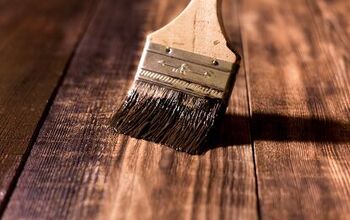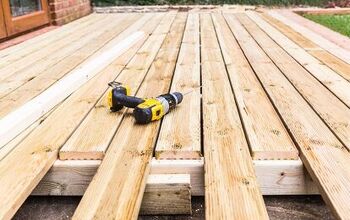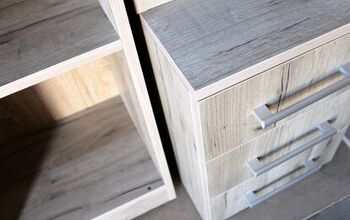Can You Dilute Wood Stain With Water? (Find Out Now!)

If you’ve ever walked through a hardware store aisle with wood stain samples, you might’ve had a moment when you looked at a stain and thought, “That would be perfect…If only it was a little lighter.” We’ve all been there, especially if you’re like me and you have a very keen eye for aesthetics. This leads many people to wonder how they can thin that stain out. You know. Just to get it the right shade. Can water work?
Whether or not you can dilute the wood stain with water depends on what the stain is made from. Water dilutes water-based stains. Meanwhile, lacquer thinner is a better fit for lacquer wood stains, and mineral spirits are best for diluting oil-based wood stains.
Using the wrong substance to thin out your wood stain is a good way to make sure that your stain is unusable. In some cases, it can even destroy your product. You’re probably wondering what you should know. Don’t worry, I have all the answers.
Do You Need Painting or Staining Services?
Get free, zero-commitment quotes from pro contractors near you.

Why Would You Need To Dilute Wood Stain?
Before we get into the art of diluting stains, it’s a good idea to explain why you might want to do this in the first place. In an ideal world, you’d never have to dilute some wood stains. You would be able to just open up the bottle and brush it on. However, this doesn’t always happen. You might want to dilute your stain for these reasons:
- The stain is already too dark right out of the jar. If you bought a stain that’s a bit too dark for your wood type, diluting can thin it out and make it lighter.
- You want to stretch your budget. Thinner wood stain means that you will have
- The stain you bought was dummy thick. Okay, jokes aside, a wood stain that is too thick can be hard to work with. It can also make it hard for the stain to cling to the wood. Thinning it out can turn your stain sprayable, which makes
- You applied too much stain to the wood. Diluting or lifting stain off the wood is a good idea here. Spills and mistakes happen. You can fix it.
Can All Stains Be Diluted?
Almost all stains can be diluted effectively, but there’s a catch. In order to make sure that you get the right consistency, you need to make sure that you get the right dilution material. Adding water to oil or lacquer-based stains will ruin the stain and cause it to be unable to stick to the wood properly. In some cases, it could actually make the stain totally unusable.
Does Diluting Your Wood Stain Change Its Ability To Soak Into Wood?
Yes and no. Diluting your wood will mean that you might need more layers to get the same pigmentation to your wood. However, the wood stain will not lose its ability to cling to wood. The only real issue that people will have with diluted wood stain is that it might end up offering slightly less protection. Thankfully, adding extra layers fixes this in a pinch.
How To Dilute Your Wood Stain Properly
If you want to dilute your wood stain, then it’s a good idea to make sure that you get the dilution process right. The majority of projects will get ruined if you do this wrong. Thankfully, many stains have instructions right on the label. If yours doesn’t, use these below.
- Begin by reading the label. The label will be able to tell you if your wood stain is based on water, lacquer, or oil.
- Grab the appropriate dilution medium. Once again, let me stress how important this is. Water for water-based stains. If you have lacquer, go for lacquer thinner. Meanwhile, oil stains tend to work best with mineral spirits.
- Pour a little bit of the stain into a cup. I find ceramic or glass works best. After all, you don’t want the stain to interact with metals.
- Add a tablespoon (or capful) of the dilution to the stain in the cup. Use a spoon to stir it gently. You should be able to notice a slight difference in the texture once it’s evenly put throughout.
- Grab a piece of scrap wood and apply the stain to it. If the stain is properly diluted, then you are good to go. Stains that are too thick can be diluted further, while stains that are too thin can be thickened up with the addition of more stain.
An Important Note About Diluting Water-Based Wood Stains
Wood stains are basically meant to be diluted, but that doesn’t mean that they are easy to dilute evenly. This is especially true when you’re talking about water-based wood stains. With water-based stains, you might notice that there’s a little extra thick stain at the bottom of your cup or flask.
If you have a little gunk puddle at the bottom of your cup, don’t ignore it. This can actually be a bit of an issue since that gunk is what makes the stain so capable of imparting color and protection. The best thing you can do is to stir up the stain until it’s more evenly mixed. To help avoid this from even being an issue, shake your stain canister before you try to use it.
Can You Spray Diluted Wood Stain Onto Wood?
You might have heard of people doing spray-on wood staining projects and wondered if you need a specialized stain for it. While there are adverts for sprayable stains on pages of Home Depot flyers, the truth is that you don’t have to buy prepaid stuff. The truth is that most professional painters and deck stainers who choose the spray method do so by diluting stains themselves.
Knowing how to properly dilute wood stains can help you save a ton of money on wood stain, especially if you are used to overpaying for sprayable stain. Since spray stains don’t require as much wiping, this method of wood staining might be a better option for jobs where time is an issue.
Do You Need Painting or Staining Services?
Get free, zero-commitment quotes from pro contractors near you.

Related Questions
Can you spray stain with an airless sprayer?
Stains can be sprayed onto a wooden surface with a wide range of different sprayers. Airless sprayers are some of the more popular ones to use, primarily because they offer up a clean, even coating range for every type of paint out there. This includes wood stains, even when you’re talking about stains that have a slightly thicker consistency like lacquer-based stains. Just make sure to dilute them.If you do not have an airless paint sprayer, then you can also choose an electric paint spray gun. If you aren’t sure whether or not a particular model works well with stain, ask a home improvement store rep.
How do you stop wood from getting too light when you’re bleaching it?
If you’re currently bleaching your wood, then you need to keep an eye on it while the bleach works its magic. Once it gets to the shade that you want it to be, apply white distilled vinegar to the wood. The acid in the vinegar will counteract the lightening effect of the bleach, making your wood’s color-changing endeavor stop in its track. To avoid sunlight lightening your wood further, add a UV-protecting sealant on top.
Should I use an oil-based stain or a water-based stain?
Oil-based stains are great if your wood will be exposed to the elements. On the other hand, if your wood is going to be primarily indoors, then you can do better with water-based stains. For the most part, using a stain that’s based on oil will make sure that you have a more resistant wood project. With that said, many people prefer that wide range of different colors that watery stains tend to have.
Related Articles

Ossiana Tepfenhart is an expert writer, focusing on interior design and general home tips. Writing is her life, and it's what she does best. Her interests include art and real estate investments.
More by Ossiana Tepfenhart



























